Simplifying GoLang with Factory Design Pattern
Welcome to this blog post, where we explore the Factory Design Pattern and its implementation in the Go programming language. In software development, design patterns play a crucial role in organizing and structuring code, making it more maintainable and extensible.
The Factory Design Pattern, a popular software design pattern, is particularly useful when we need to create objects without specifying their concrete types up front.
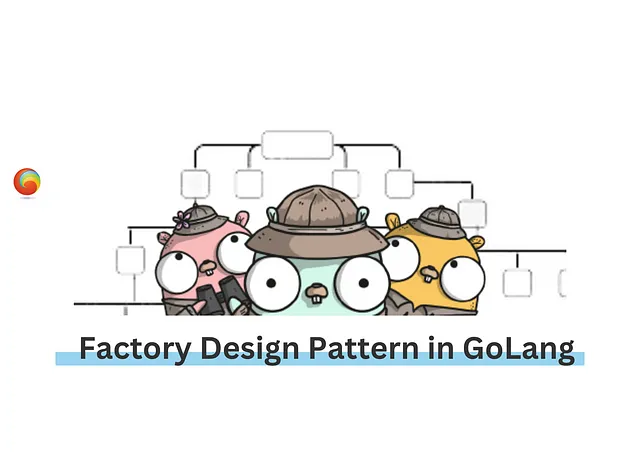
Factory Design Patterns In Golang
Let’s dive in and explore how we can leverage this factory design pattern in GoLang.
Understanding the Factory Design Pattern in GoLang
The Factory Design Pattern in GoLang falls under the category of creational design patterns. Its primary goal is to provide an interface for creating objects while allowing subclasses to decide which class to instantiate. This pattern promotes loose coupling by decoupling object creation from the client code.
Key Components
Product: The abstract interface representing the objects the factory creates.
Concrete Products: The specific implementations of the product interface.
Factory: The interface or class responsible for creating objects.
Concrete Factory: The class that implements the Factory interface and produces specific instances of the Product.
Implementing the Factory Design Pattern in GoLang
Let’s see an example of how to implement the Factory Design Pattern in GoLang:
package main
import "fmt"
// Product interface
type Car interface {
Drive() string
}
// Concrete Products
type Sedan {}
type SUV {}
func (s *Sedan) Drive() string {
return "Driving a sedan car"
}
func (s *SUV) Drive() string {
return "Driving an SUV"
}
// Factory interface
type CarFactory interface {
CreateCar() Car
}
// Concrete Factory
type SedanFactory {}
type SUVFactory {}
func (sf *SUVFactory) CreateCar() Car {
return &SUV{}
func (sf *SedanFactory) CreateCar() Car {
return &Sedan{}
func main() {
// Create a sedan car using the sedan factory
sedanFactory := &SedanFactory{}
sedan := sedanFactory.CreateCar()
fmt.Println(sedan.Drive())
// Create an SUV car using the SUV factory
suvFactory := &SUVFactory{}
suv := suvFactory.CreateCar()
fmt.Println(suv.Drive())
}
In this code example, we’ll walk through the implementation of the Factory Design Pattern in GoLang, step by step.

Factory Design Pattern in Golang — Defining Car Interface
Firstly, we define the Car interface, which represents the product that our factory will create. The interface declares the Drive() method, which all concrete products must implement.
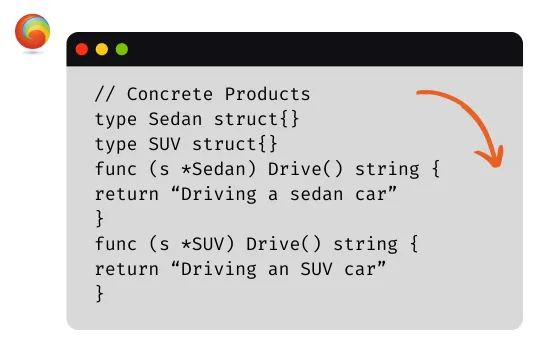
Factory Design Patterns In Golang — Defining concrete products
Next, we define the concrete products: Sedan and SUV. These concrete types implement the Drive() method according to their specific behavior.
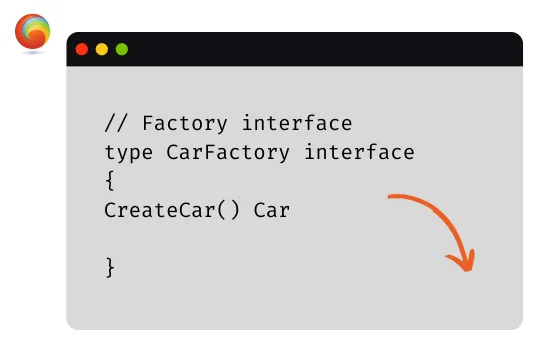
Factory Design Patterns In Golang — Defining CarFactory interface
Moving on, we define the CarFactory interface, which declares the CreateCar() method. This method will be responsible for creating the cars. It returns an object that satisfies the Car interface.
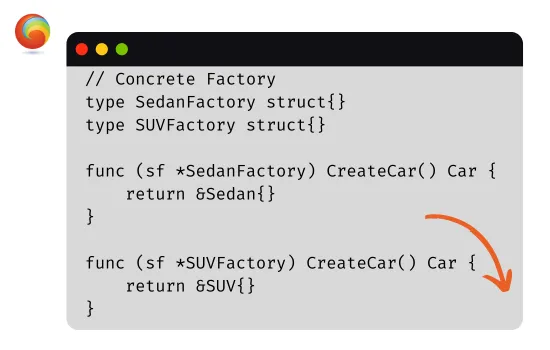
Factory Design Patterns In Golang — Implementing Concrete factories
We then implement the concrete factories: SedanFactory and SUVFactory. These factories implement the CarFactory interface and provide the logic to create specific concrete products. The CreateCar() method in each factory returns an instance of the corresponding concrete product.
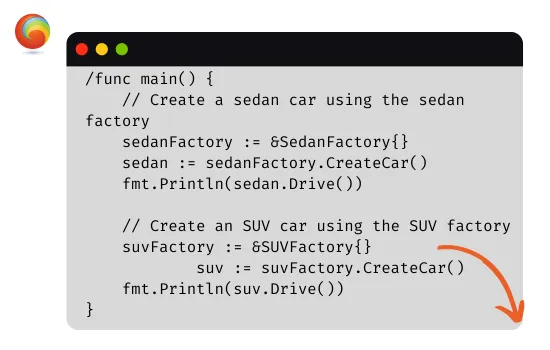
Factory Design Patterns In Golang — Demonstrating how to use the factory
Finally, in the main() function, we demonstrate how to use the factory to create different types of cars. First, we create a sedan using the SedanFactory and assign it to the sedan variable. We then call the Drive() method on the sedan to showcase the specific behavior of the sedan. Similarly, we create an SUV using the SUVFactory and display its behavior using the Drive() method.
By using this Factory Design Pattern in GoLang, we can create objects without directly referencing their concrete types. This promotes loose coupling and flexibility in our codebase.
Benefits and Use Cases
The Factory Design Pattern in GoLang offers several benefits, including:
Increased flexibility: By decoupling object creation from the client code, it becomes easier to introduce new product variations or extend the existing ones.
Simplified client code: The client code only needs to work with the abstract product interface, providing a clear separation of concerns.
Improved testability: With the use of interfaces and dependency injection, it becomes easier to write unit tests for the client code.
The Factory Design Pattern is useful in various scenarios, such as:
Creating objects based on runtime conditions or configuration.
Providing an encapsulation layer for object creation.
Managing object creation in a centralized manner.
Conclusion:
In this blog post, we explored the Factory Design Pattern and its implementation in GoLang. By leveraging this pattern, we can achieve loose coupling and enhance the flexibility and maintainability of our codebase.
The Factory Design Pattern allows us to abstract away the object creation process and work with objects through a common interface. If you haven’t used this pattern before, give it a try and see how it can improve the structure of your GoLang applications.
The Factory Design Pattern in GoLang can be complemented by exploring topics such as mental models and neuroscience and the art of teaching. By applying the principles of mental models and neuroscience, we can create code that aligns with how our brains process information while leveraging the art of teaching can improve our ability to effectively communicate design patterns like the Factory to others, fostering collaboration and knowledge-sharing.
Thank you for reading!
To learn more about The Factory Design and Go language please visit our website and join us!
Frequently Asked Questions
What is the factory method in Go?
- The Factory Method in Go is a design pattern that provides an interface for creating objects, allowing subclasses to decide which concrete class to instantiate. It promotes loose coupling by decoupling object creation from the client code.
What is a factory in design pattern?
- In the context of design patterns, a Factory is a creational design pattern that provides an interface or class responsible for creating objects. It encapsulates the object creation logic and allows the client code to create objects without knowing the specific implementation details.
What is the state design pattern in Golang?
- In Go, the State Design Pattern is a behavioral design pattern that allows an object to alter its behavior when its internal state changes. It encapsulates different states of an object into separate classes and defines a common interface for accessing the behaviors associated with each state. The State pattern promotes loose coupling and simplifies complex conditional logic by delegating the behavior to the respective state objects. It allows objects to change their behavior dynamically at runtime by transitioning between different states.
What type of design pattern is a factory?
- The Factory pattern is a creational design pattern.
